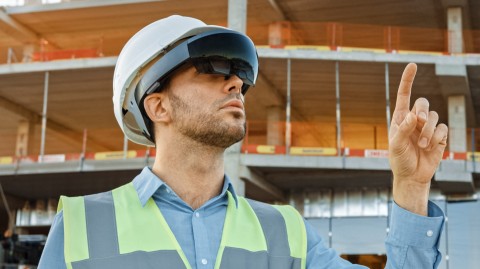Wi-Fi is not what it used to be
Behind the wall is where it's at
Wi-Fi has become so ubiquitous that users only really become aware of it when it stops working to their satisfaction. This can generally be put down to one of three things in a modern-day industrial building: The nearest access point is too far away. Or the user has taken their laptop, tablet or smartphone into a Wi-Fi “black hole”, i.e. behind a steel wall that blocks the wireless signal. Or – as is increasingly the case – the system is just plain overloaded. It’s no wonder: Data volumes, even for conventional communications applications, have positively exploded since the first networks were installed.
If complaints start to pile up, it’s a good idea to see if the problem can be addressed with a small improvement such as installing more access points. However, in many cases, the best approach in a professional setting is to completely redesign and future-proof the network. This optimization process is called a network or Wi-Fi redesign.
Range and bandwidth requirements have increased in response to a wide array of convergent, divergent and parallel trends:
- New forms of work organization such as shared desks or shared spaces require everyone to have complete data access from every corner of the company.
- However, Wi-Fi is about more than simply liberating people from their fixed desks. Even a basic office building will have more than one Wi-Fi network these days.
- In addition, modern operations will have at least one guest Wi-Fi network alongside other internal networks that can only be accessed by people in specific departments or with specific security authorizations. It should also be noted that all these trends “only” relate to communications between people or access to human-generated information.
Another trend that has sent data volumes soaring is human-machine communication. There is currently a big shift toward " mobile maintenance ", i.e. applications that support remote machine and plant maintenance. Soon, these rapidly evolving, far more data-intensive technologies will become an integral part of normal industrial operations – just look at augmented reality. They will play an increasingly important role for manufacturers with sophisticated process equipment. However, technology cannot free up maintenance technicians’ and machine operators’ hands to work until they are issued wireless smart glasses.
Wireless technology is increasingly powering machine-to-machine communications, too. Industry 4.0, big data and automation have placed largely autonomous devices at the heart of the industrial process. They range from automatic cleaning machines to self-driving forklifts. There has been an increase in the importance of inspection and maintenance robots that can get to places that are difficult for people to navigate – such as sewer lines or spaces filled with toxic gases. Wi-Fi, in other words, will be needed not just in factories, but also in portions of buildings that people don’t normally access. Companies that are not yet preparing for this reality have already fallen behind the rest of the industry.
The significance of building automation is growing, too: smart and/or centralized control of ventilation and heating systems, blinds, door locks, safety equipment and everything that janitors used to personally oversee. For obvious reasons, it is a good idea to transfer this data over dedicated, independent networks.
All these trends are driving massive increases in global data volumes, causing them to at least double every two years. That underscores the fact that Wi-Fi redesigns need to cover more than just the space between the device and the point where the communications signal appears or disappears in the wall. Every Wi-Fi network taps into a central nervous system, a physical wired network. This is the only thing that can route data from the outside world into the company, from inside the company to the outside world and to different recipients within the same site.
All these activities are performed by a host of ever-smarter hardware components that have to be carefully and precisely positioned within and outside the building. Their placement depends on more than just how long the cables can be and where they can be routed. Factors such as wall construction play an important role as well (reinforced concrete is a bigger obstacle than drywall). Also, wireless systems tend to be prone to malfunction.
The technical requirements are thus enormous, especially in the chemical and pharmaceutical industry.
1. The first stage of the Wi-Fi redesign involves assessing the customer’s exact needs and producing a digital design based on floorplans.
2. In the second stage, all the cables and components are installed, mounted and connected; the documentation is produced.
3. In the third and final phase of the Wi-Fi redesign , the finished system goes through an exhaustive practical test in order to discover any bugs to be fixed. The data network can then be handed over to the customer and taken live.

The ‘trivial’ ancillary processes are often forgotten in IT investments. There are few providers that can perfectly coordinate all the trades required for high-availability facility operation and supply a one-shop-stop solution. Moreover, we have decades of intimate familiarity with the specific requirements of the chemical, pharmaceutical and process industries. With us at your side, you can be confident that your business will keep running smoothly. And that your network will be future-proof for the foreseeable future.
Andreas Goeres, Head of IT Sales / Design and Event IT at Infraserv Höchst



